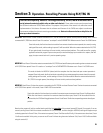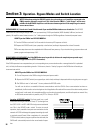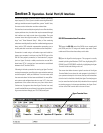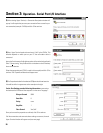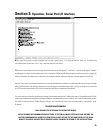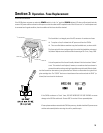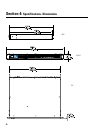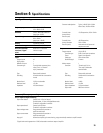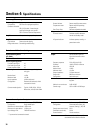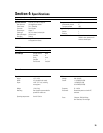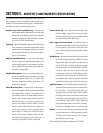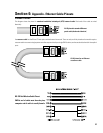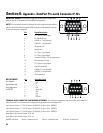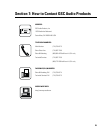
SECTION 5 : ARCHITECT’S AND ENGINEER’S SPECIFICATIONS
The Amplifier Network Monitor shall provide input, output, and
status control for DataPort equipped QSC power amplifiers in an
Ethernet-TCP/IP based network audio system. Sixteen indepen-
dent channels shall be provided, grouped in pairs.
Amplifier Input Control and Monitoring—For each of the
sixteen power amplifier input signals, the CM16a shall
provide level, mute and polarity control, pre and post fade
signal level metering and audio monitoring, and select-
able 1Vrms or 3Vrms input sensitivity.
Page Input- The Amplifier Network Monitor shall provide a page
input, separate from the normal program inputs, whose
signal may preempt the program signal of any or all of the
sixteen program channels. This input shall have select-
able 1V or 3V sensitivity.
Amplifier Output Monitoring—For each of the sixteen power
amplifier outputs, the Amplifier Network Monitor shall
provide clipping detection, short and open circuit de-
tection, voltage and current metering, and audio moni-
toring of the voltage signal.
Amplifier Management—For each of the eight DataPort con-
nections, the Amplifier Network Monitor shall provide
AC standby/operate mode control, AC power state
indication, temperature metering, load status, and
protect status detection.
Audio Monitoring Chain—For each of the sixteen program
channels, the Amplifier Network Monitor shall provide
three monitor points as follows: (1) pre-fader control,
(2) post-fader control, or (3) power amplifier output. A
channel’s monitor output may be selected from one of
these three signals, or it may be switched off. The
signal at the Amplifier Network Monitor’s monitor
output connector shall be the sum of the signal at its
monitor input connector and four selected channel
monitor signals. A monitor gain control shall be pro-
vided for each monitor tap point to adjust the indi-
vidual levels of the channel monitor signals prior to
their being mixed with the monitor input signal.
Contact Closure I/O—The Amplifier Network Monitor shall
provide a trigger contact-closure sense input which
shall also be CMOS & TTL signal compatible, and one
dry-contact floating SPDT relay output.
Input Trigger Stand-alone Mode- The Amplifier Network
Monitor shall be capable of recalling up to two Presets
by the triggering of the contact-closure sense input
alone. The user shall have the option to enable/disable
this function.
Data Network—All Amplifier Network Monitor functions shall
be controlled and monitored via a 10BASE-T Ethernet
digital control network using the IP transport protocol
and the QSControl monitoring application protocol.
Rear-panel connection shall be provided for 10BASE-
T Ethernet. Other than the AC power switch and
manual bypass switch, the Amplifier Network Moni-
tor shall have no manual controls. The Amplifier Net-
work Monitor shall continue to operate uninterupted
should the network connection be lost for any reason.
Amplifier Interface—The Amplifier Network Monitor’s inter-
face to each power amplifier Data Port shall be via an
HD-15 connector. The amplifier interface shall use a
standard personal computer Video Graphics Adapter
(VGA) CRT monitor cable. This interface shall transmit
two amplifier input audio signals as well as all control
and monitoring signals. Special signal conditioning
and grounding techniques shall be used in this inter-
face to ensure negligible levels of noise and crosstalk.
General—All audio inputs and outputs shall be balanced with
a nominal input level of +4 dBu and maximum level of
+21 dBu. Input connectors shall be of the “Phoenix”
detachable terminal strip type.
The Amplifier Network Monitor shall be the QSC CM16a.



